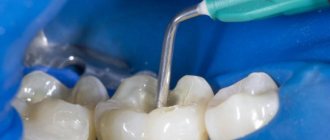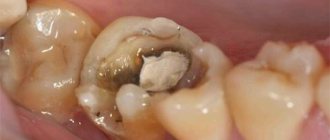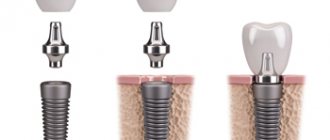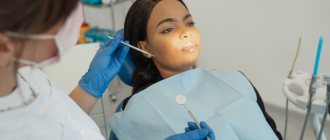Often dental treatment is not limited to just one visit to the doctor - in this case, at an intermediate stage, a temporary filling cannot be avoided. It is mainly used in the following cases:
- Treatment of acute deep caries. The border between dental tissues and the pulp chamber is so thin that the carious process can develop into pulpitis, and then root canal treatment will be required. Therefore, at the first visit, the dentist places a medicinal lining in the tooth and closes the cavity with a temporary filling. If the tooth continues to hurt under it, this indicates the need to change tactics.
- Treatment of pulpitis. In most cases, pulp inflammation is treated in two visits. First, it is necessary to necrotize the vessels and nerves so that later removal of the affected tissue and treatment of the canals will not be painful. To do this, during the first visit, a temporary filling with arsenic is placed.
- Treatment of periodontitis. Depending on the stage of the disease, medicine is placed into the root canals to stop the inflammatory process or to restore bone tissue (when a cyst is removed). In both cases, a temporary filling is needed. At each appointment, the dentist checks the condition of the root canals, as well as the tissues adjacent to it, and decides whether it is possible to permanently fill the tooth or whether it is worth putting a new portion of the drug.
- Preparation for prosthetics. In some situations, a temporary filling is placed on already cured and filled canals - for example, before installing a pin or orthopedic structure.
Composition of temporary filling
The main difference between temporary fillings and permanent fillings is their composition. They are usually made from the following materials:
- Artificial dentin. This is a mixture of zinc oxide and sulfate powders with distilled water.
- Vinoxol. It is a mixture of zinc oxide powder and liquid. It has good adhesion and antiseptic properties, and due to its high strength, a temporary filling made from this material can last up to six months.
- Dentine paste. White homogeneous mass with essential oils. The material is plastic, has excellent adhesion, and has water-repellent properties.
- Zinc-eugenol cement. It contains zinc oxide and clove oil or the fragrant substance eugenol. A temporary filling made from this material has good adhesion, an analgesic effect, antiseptic properties, and resistance to increased loads.
- Polycarboxylate cement. It is a mixture of zinc oxide powders, copper and liquid. It has good ductility, resistance to moisture, and excellent adhesion.
- Karyosan - zinc oxide with eugenol.
All materials have their own hardening time and the period after which food can be eaten. For each case, the dentist himself determines the type and composition for filling the cavity, which will affect the price of the temporary filling.
Arsenic poisoning
Before doctors arrive, the victim should be induced to vomit. To do this, he is given 0.5-1 liter of clean water to drink, after which he is pressed with his fingers on the root of the tongue. The manipulation is carried out several times until a clean washing liquid begins to flow away, in which there are no foreign impurities. Next, the patient must be laid down and an influx of fresh air must be provided. For unconscious people, gastric emptying is contraindicated.
First aid
Acute arsenic poisoning requires first aid on the spot. The patient is advised to undergo gastric lavage using at least 10 liters of water mixed with adsorbent. After the procedure is completed, the patient is given 8-10 tablets of activated carbon and 50-100 ml of magnesium sulfate to drink as a laxative. An alternative is unithiol administered into the stomach through a tube. The same drug is infused intramuscularly.
At the prehospital stage, other measures are taken to maintain vital functions. To eliminate hypovolemia and correct electrolyte balance, infusion therapy is started. Anticonvulsants are used for seizures. In order to reduce pain, antispasmodics and analgesics are prescribed. Transfer to mechanical ventilation and titrated supply of vasopressors may be required.
Hospital treatment
Unithiol therapy continues in the hospital setting. The drug is prescribed in a course of 5-6 days. In its absence, the patient should receive N-acetylcysteine, which acts as a donor of monothiol groups. In case of damage by arsenous hydrogen, mecaptide is added to the regimen. Active methods of detoxification are required: intestinal lavage with the introduction of 8-10 liters of saline enteral solution into the intestines, hemodialysis, repeated gastric lavage.
After intestinal lavage is completed, the patient is given an antidiarrheal drug to drink. Infusion of saline solutions is required; in case of severe dehydration, infusion of colloids. Adult patients can receive fluids by mouth (rehydration solutions) as long as this does not cause vomiting. Additionally, glucocorticoids, ascorbic and nicotinic acid are prescribed. Severe metabolic acidosis is eliminated with sodium bicarbonate.
Recovery
After discharge from the hospital, the patient is recommended to be monitored by a local therapist to exclude the development of delayed consequences of chemical injury. It is possible to visit gastroenterological sanatoriums. Food must meet the requirements of table No. 4 according to Pevzner. Restrictions must be observed until the gastrointestinal tract is completely stabilized.
How much does a temporary filling with arsenic cost?
The period for which a temporary filling with arsenic can be left in a tooth depends on various circumstances - the age of the patient, the condition of his teeth, as well as the means used by the dentist to kill the pulp. When setting the time frame, the option of placing the drug is also taken into account - on an unopened pulp chamber or directly on the exposed pulp.
Typically, a temporary filling with arsenic remains in the tooth for a day, but when treating multi-channel chewing teeth, this period can be increased to two days. When treating baby teeth with formed roots, this time is reduced to 18 and 24 hours, respectively. And if the latest generation of arsenic preparations are used, they can be left in the tooth for up to five days.
If you have been given a temporary filling with arsenic, you must strictly adhere to the deadlines and come to replace it at the time specified by the doctor. Prolonged residence of the drug in the tooth leads to the penetration of arsenic into neighboring tissues and its accumulation there, which can ultimately provoke periodontal inflammation.
More information on the topic
When they use arsenic and why, you will learn even more in the articles:
- Deep caries
- Treatment of periodontitis
- Dental prosthetics
References for the article:
- Kostina I.N., Nikolaeva A.A. “Arsenic necrosis of the jaw - complications in the treatment of dental pulpitis” // “Problems of Dentistry” No. 3, 2010.
- "Endodontics. Pulp diseases" // Textbook / A.S. Opravin et al. – Arkhangelsk: Publishing House of the Northern State Medical University, 2016.
Why might a filling fall out?
Premature opening of a tooth cavity with arsenic embedded in it most often occurs due to the use of low-quality materials in its manufacture. In addition, the dentist himself can violate the technology: position the filling incorrectly, leave a gap between it and the tooth, poorly clean the carious cavity, and so on. Any medical violation is fraught with consequences; a filling can fall out even without them. For example, if the patient has very thin tooth enamel and lacks calcium and fluoride, or if he frequently eats solid foods. Loss of a filling can be caused by poor oral care, mechanical damage and bad habits. In any case, you cannot postpone your visit to the dentist.
When should you see a doctor?
As soon as the period of wearing the temporary filling, determined by the doctor, has ended, you need to see a dentist (see also: how many hours can you eat after installing the temporary filling?). He will remove the material, clean the canals and seal them. You also need to make an appointment with a doctor if:
- If a temporary filling falls out. The doctor will determine why this happened, apply another temporary composition or replace it with a permanent one.
- If the pain occurs even at night.
- If the pain is acute.
- When soft tissues are swollen or a severe allergic reaction occurs.
- With high temperature and fever.
Any complication after applying arsenic is beyond the norm, so it is better not to endure it, but to immediately consult a doctor. He will assess the condition and, if necessary, be able to prevent the development of pathology. Remember that arsenic is a poison, so you need to be careful when using it.
Modern dentistry
Today, arsenic is not used in its pure form, but is included in various devitalizing drugs.
Regardless of their name, the composition is often the same:
- fast-acting anesthetic;
- a substance that allows you to roll the paste into balls;
- antiseptic;
- an astringent component that slows down the absorption of arsenic into the pulp - tannin;
- arsenic anhydride itself.
Pain after applying the product
For how many days is arsenic administered during dental treatment? For each person, this issue should be considered individually, but in any case, the substance should relieve painful sensations almost immediately after installation. The rapid anesthetic effect of the pastes is ensured by lidocaine, novocaine or dicaine included in the composition. If, even after a visit to the dentist, the pain does not subside, and sometimes manifests itself with even greater force, then, most likely, the doctor put an insufficient amount of the drug into the tooth or did it on a closed pulp, which provokes severe pain and swelling.
Of course, in addition to the possibility of medical errors, pain can occur for other reasons, for example:
- with an increased individual sensitivity threshold;
- slow effect of the drug;
- drug-induced inflammation;
- individual intolerance to any of the components of the paste.
The latter is fraught with serious consequences, so if swelling begins to increase along with pain, it is necessary to urgently call an ambulance. Drug-induced inflammation is also accompanied by swelling and increased body temperature. It provokes an abscess on the gum. The painful area should be immediately examined by a specialist.
Pain may not occur immediately after laying. Most often, they indicate the beginning of the death of the jaw bones, so the drug must be immediately removed from the tooth cavity. In any case, you shouldn't endure the pain. It is better to immediately contact a specialist for help.
How long does a tooth hurt after arsenic administration?
To start the necrotic process in the tooth, dentists use arsenic in the form of a special paste; it also contains antiseptics, an anesthetic and a filler that helps give the paste its shape.
Read also: Does tea help with a hangover?
Why does the tooth sometimes start to hurt again? There are several reasons for this:
Usually the pain is aching in nature or appears with pressure. Tissue necrosis takes 2-3 days, and all this time the tooth may continue to hurt. If severe swelling occurs, consult a doctor.
Self extraction
If the doctor incorrectly calculated how many days you can keep arsenic in the tooth, then its negative effect on the body will begin before it is time to take it again. Very often, patients are unable to get an appointment ahead of schedule due to days off at the clinic or with the specialist himself, which provokes the need to independently remove the paste from the tooth.
To do this, you first need to remove the seal. They are most often soft and easily removed with a syringe or sewing needle. The paste itself should also be removed with a sharp instrument or tweezers. It is very important not to swallow it at this time. After extraction, the oral cavity is rinsed with a soda solution with the addition of iodine or hydrogen peroxide. Regular milk will also help neutralize the remains of arsenic, which also needs to be thoroughly rinsed out of your mouth.
All needles or other devices for work must be disinfected, and the open dental cavity after the procedure is covered with a cotton swab. It is strictly forbidden to drink alcohol while there is toothpaste in the tooth, as it enhances the effect of the toxic substance.
A visit to the dentist should be made at the first opportunity, since with the lack of qualified assistance there is a risk of complications.
Prohibitions on use
How long can you keep arsenic in your tooth? The drug is used strictly individually; if at least one of the listed conditions is present, it is strictly contraindicated.
Prohibitions include:
- individual intolerance to the substance and additional components;
- glaucoma;
- resorption or incomplete formation of tooth roots;
- ailments of the genitourinary system;
- inability to clean channels;
- separation or perforation of tooth roots;
- children's age up to 1.5 years.
Ignoring these restrictions can lead to serious complications, including:
- pulp swelling;
- blackening of dentin;
- poisoning of the whole body;
- necrosis of the jaw bone;
- swelling of the periodontal tissues.










